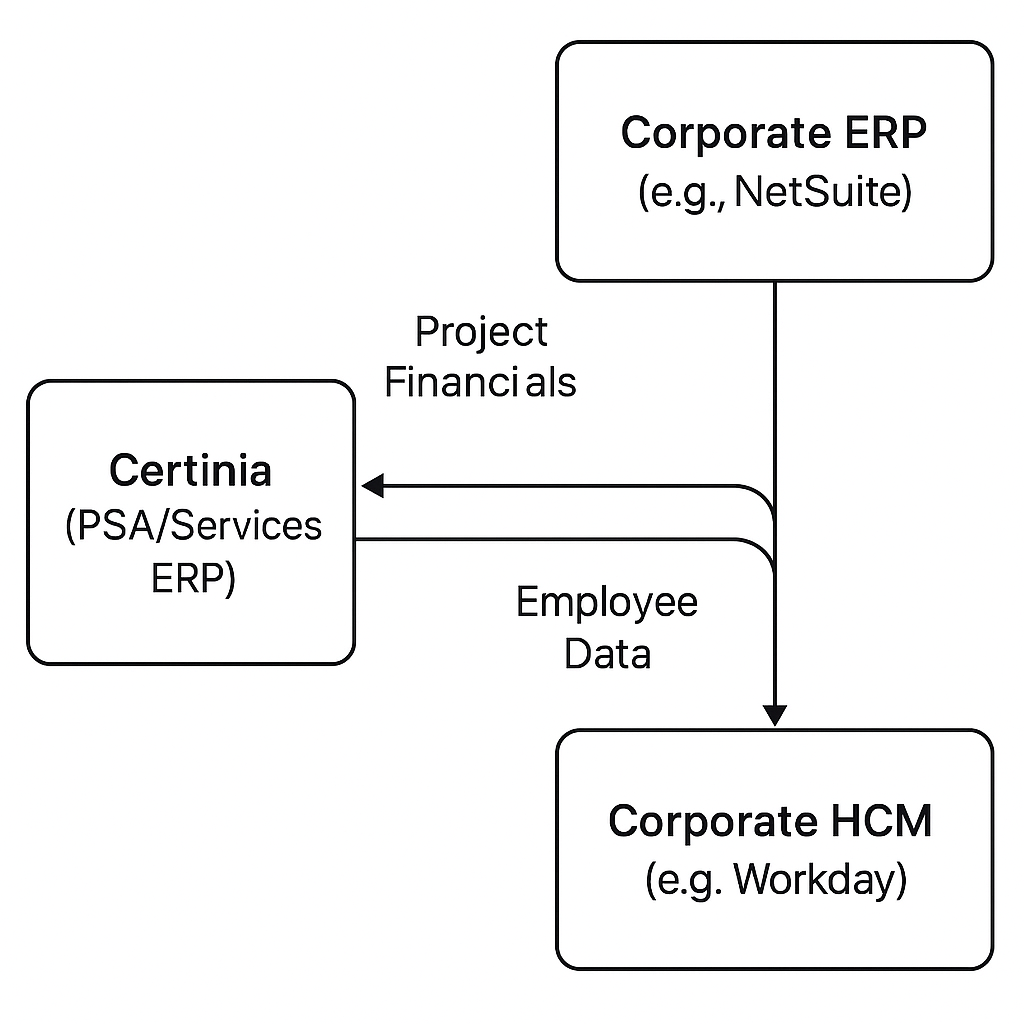
Table of Contents
We’ve established the strategic need for a services-centric platform and analyzed Certinia as a prime example. The final piece of the puzzle is understanding how such a system coexists within a larger enterprise architecture. A perspective forged through years of navigating real-world enterprise integrations suggests that even a unified platform doesn’t operate in a vacuum. Effective integration with corporate ERP and Human Capital Management (HCM) systems is critical for success.
The architectural pattern that most often emerges is a “hub-and-spoke” model. In this setup, the PSA platform (like Certinia) acts as the operational hub for the entire services line of business, managing everything from project quoting to resource management and revenue recognition. It then feeds summary-level financial data into the corporate ERP, which functions as the system of record for consolidated financial reporting. Why this approach? It allows the services business to operate with the speed and flexibility it needs, without burdening the corporate financial system with granular project-level detail it wasn’t designed to handle.
Key Integration Points
Drilling down, the key data flows are quite specific and must be carefully architected.
- PSA to Corporate ERP: This is the most critical financial link. The integration should be designed to post journal entries from the PSA’s sub-ledger to the corporate general ledger. This ensures that recognized revenue, project-related costs, and services billing are accurately reflected in the company’s consolidated financial statements. A common pairing here involves connecting systems like Salesforce and NetSuite.
- Corporate HCM to PSA: Your people are your product. The PSA system needs access to core employee data (roles, skill sets, cost rates, and department information) to function effectively. This information typically lives in a corporate HCM like Workday or ADP. A well-designed integration ensures that the resource pool in the PSA is always up-to-date, which is foundational for accurate project staffing and capacity planning.
Technical Implementation Considerations
The practical implementation of these integrations requires careful attention to several technical dimensions that can make or break the overall architecture.
Data Synchronization Strategies
Real-time versus batch processing decisions fundamentally shape the integration architecture. For financial data flowing from PSA to ERP, many organizations implement near-real-time synchronization to support accurate financial reporting and cash flow management. However, employee master data from HCM to PSA typically operates on a scheduled batch basis, as organizational changes happen less frequently and don’t require immediate propagation.
The key is matching synchronization frequency to business criticality. Project billing data needs rapid flow to support customer invoicing cycles, while skill set updates can tolerate longer delays without operational impact.
Error Handling and Recovery Patterns
Integration failures are inevitable, making robust error handling essential. Successful implementations typically employ a multi-tier approach: automatic retry logic for transient failures, dead letter queues for persistent issues, and clear escalation paths for manual intervention. The financial integration points especially require comprehensive audit trails and reconciliation capabilities to maintain data integrity across systems.
Change Management and Organizational Impact
Beyond the technical architecture lies the human dimension of integration success. Services organizations often struggle with the cultural shift from departmental tools to integrated enterprise systems. The key is demonstrating clear value at each organizational level.
Project managers need to see how integrated resource data improves staffing decisions. Finance teams must understand how automated journal entries reduce manual reconciliation effort. Executive leadership requires visibility into how integrated reporting enables better strategic decisions about services profitability and capacity utilization.
Training programs should focus not just on system mechanics, but on the business processes enabled by integration. When users understand how their daily work connects to broader organizational outcomes, adoption accelerates significantly.
This model creates a powerful, layered architecture. You get the best of both worlds: a specialized, highly efficient system managing the complexities of the services lifecycle, and a stable, consolidated system of record for corporate governance and reporting. It’s a pragmatic and resilient strategy for building an enterprise architecture that can truly power a modern services organization.
For more insights into enterprise architecture and digital transformation, connect with me on LinkedIn.